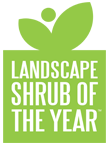SHADOWLAND® ‘Autumn frost’
Hosta
Shining In Shade
- Luminous perennial for shade
- Frosty blue and electric yellow variegated leaves in spring
- Creamy white margins in summer
- Thick, durable foliage
- Light lavender flowers
- Attracts hummingbirds
- 10-12″ tall x 20-24″ spread
- Perennial in USDA Zones 3-9
If you garden in shade, you’re surely familiar with hostas. These dependable perennials enjoy such broad popularity because they are easy to grow in any degree of shade and aren’t phased by the most extreme winters. Add ‘Autumn Frost’ to a shaded nook and you’ll instantly see how it lights up the space with its broad, glowing yellow margins and sea blue centers. Versatile in containers and landscapes without growing too large, it’s easy to find the perfect spot for this hosta to shine.
how to grow shadowland® ‘autumn frost’
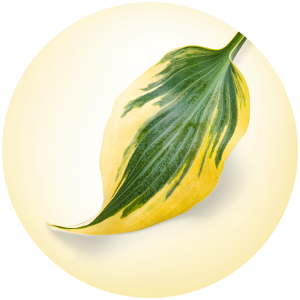
Planting
When choosing a spot to plant ‘Autumn Frost’, consider that it prefers to grow in morning sun or dappled sun throughout the day. Afternoon sun can be too strong and burn the foliage, especially in warm climates.
The first place you might consider planting your new hosta is under a tree. If the tree is deeply rooted, like an oak or hickory, there will be plenty of room for the hosta’s roots to grow. But maples, birches and spruce trees have broad, shallow root systems that could outcompete the hosta for root space. Consider root competition when finding the right spot.
‘Autumn Frost’ grows best in humus-rich soil that is moist and well-drained, but it will also grow reasonably well in sandy and clay soils. Use a good quality potting soil with a bit of slow release plant food mixed in if you plan to grow it in a container.
This hardy perennial isn’t too fussy about when you plant it. Cooler spring and fall weather is ideal, but if summer is your only option, just be sure to plant it in the shade and keep the soil moist through the warmest months while its roots get established.
When planting, dig the hole about twice as wide but just as deep as the container it is growing in. If your soil is light in color–indicating it doesn’t contain much organic matter–add several handfuls of humus, compost or aged manure when you backfill the hole. That will provide extra nutrients and water-holding capacity to the soil.
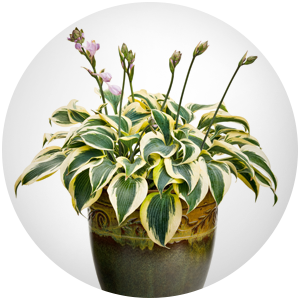
Maintenance
Hostas require very little maintenance during the growing season. They need little more than some shade, good soil and moisture to flourish all on their own.
Watch for rabbits in sprint–this is their favorite time of year to munch on hostas. Just as their pointed tips emerge from the soil, a hungry bunny may come along and nip them off. It won’t hurt the hosta but once its leaves unfurl, you’ll see the bunny’s teeth marks. Avoid this by applying animal repellent on your hostas in early spring just as they start to come up.
If deer are an issue in your garden, consider growing more deer resistant plants or plan to protect your hostas with animal repellent or fencing. Taller, thinner leaved cultivars are more prone to damage simply because they are easier for the deer to eat.
During wet weather, slug populations can multiply quickly. If you start seeing holes in your hosta leaves, it’s a sure sign that they have moved in. Here is an article to help you “slug it out” with these pesky creatures.
Hostas should be cut back in fall once their foliage has gone to sleep for the season. Remove the spent foliage from the garden bed and dispose of it to help avoid future slug damage around the plants.
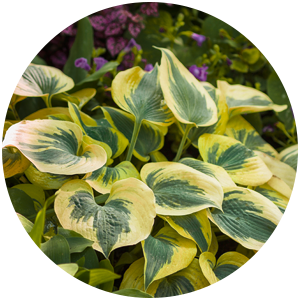
Companion plants
The broad textured foliage of ‘Autumn Frost’ contrasts beautifully with shade loving perennials that have lacy leaves like ferns, goatsbeard, astilbe and strappy leaved sedges. Its bright tones are easily complemented with brightly colored Dolce® and Primo® heuchera or the fluffy blossoms of bee balm.
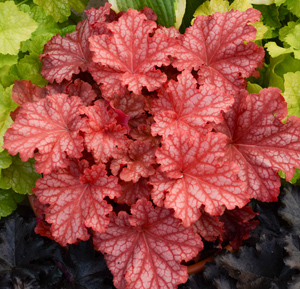
Primo® Peachberry Ice Heuchera
When pairing your hostas with other plants, look for those that prefer similar cultural conditions, including a preference for shade and rich, moist soil. Your local garden center likely has a separate section for shade perennials where you’ll find all sorts of companions for ‘Autumn Frost’.
If the roots are densely circled around when you take the plant out of the pot, loosen them up a bit to break the “root memory”. This will encourage them to grow outward instead of continuing to grow in a circular pattern.
Set the plant in the hole, making sure that the top of the rootball is level with the top of the surrounding soil. Then backfill the hole with the soil you dug out and any amendments you may have added. Press it down with your hand firmly to eliminate any big air pockets around the roots.
Lastly, water the plant again to help the soil settle. Spread some mulch around the base of the plant, taking care to keep it from touching the plant’s stems. The mulch will help to retain soil moisture and protect the roots during winter.
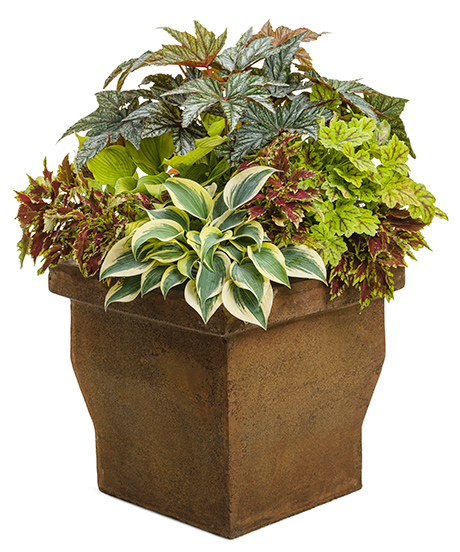 Nightingale recipe
Nightingale recipe
Shadowland® ‘Autumn Frost’ Hosta
Pegasus® Begonia
ColorBlaze® Royale Apple Brandy® Coleus
Shadowland® ‘Coast to Coast’ Hosta
Click the plant names for more information
top 3 reasons to
grow ‘Autumn
frost’ Hosta
it will be the most distinctive hosta in your garden
The luminous colors of this hosta in spring are second to none. It’ll be the first one you notice in your shade garden.
it’s super cold hardy
Hardy down to -40°F, you will never have to worry about this perennial returning reliably every year.
it will thrive in your shadiest places
While many showy perennials need full sun to thrive, ‘Autumn Frost’ will happily light up your shade garden with its glowing hues.
